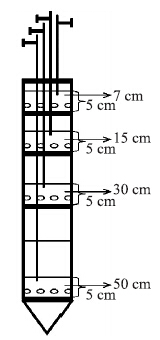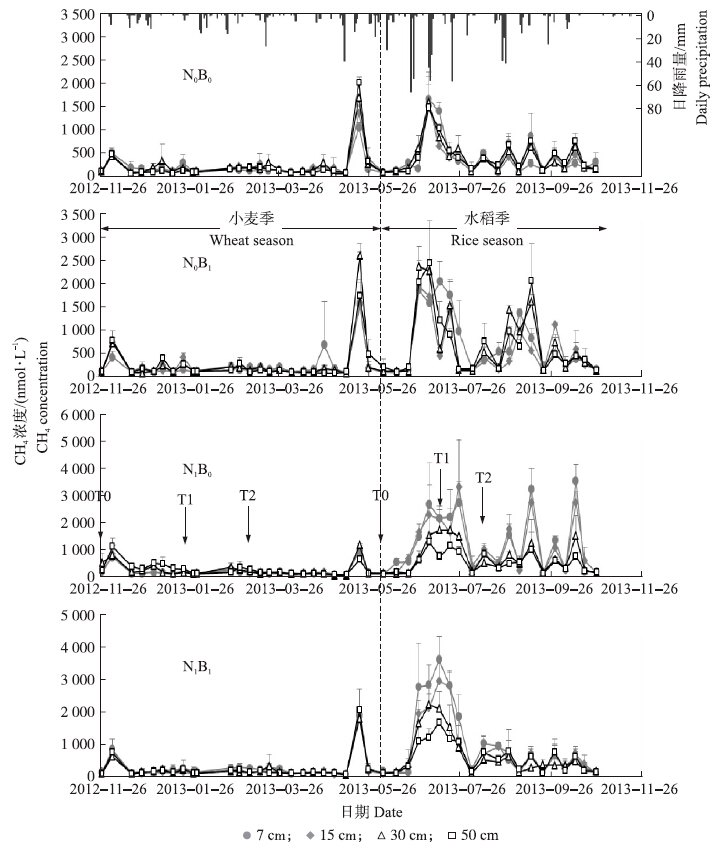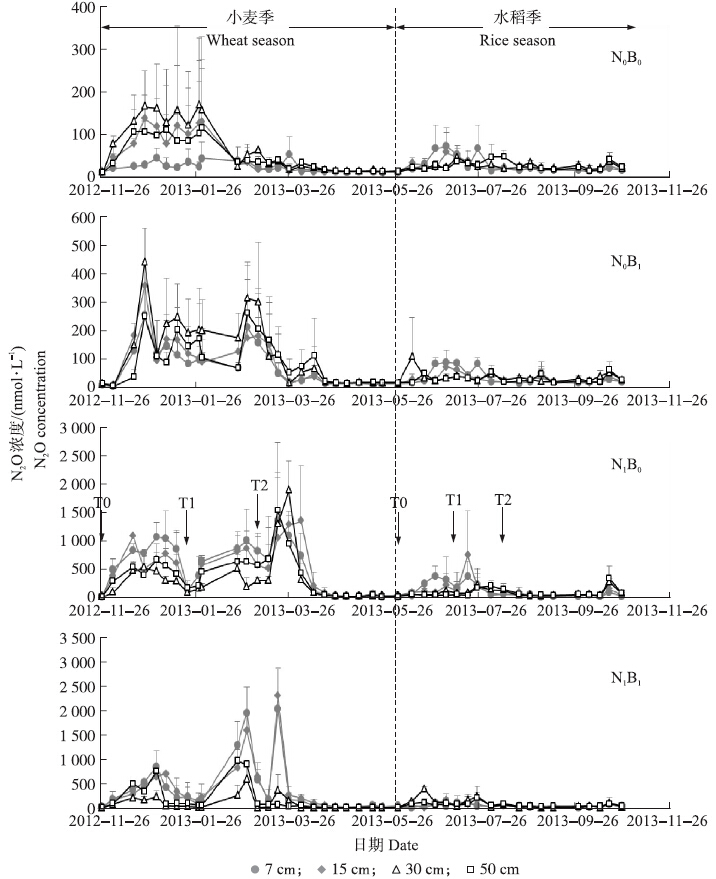文章信息
- 周自强, 李露, 张恒, 熊正琴. 2015.
- ZHOU Ziqiang, LI Lu, ZHANG Heng, XIONG Zhengqin. 2015.
- 氮肥配施小麦秸秆生物炭对稻麦轮作土壤剖面CH4和N2O浓度的影响
- Effects of wheat straw biochar and nitrogen amendment on methane and nitrous oxide distribution characteristics within soil profile in rice-wheat annual rotations
- 南京农业大学学报, 38(3): 431-438
- Journal of Nanjing Agricultural University, 38(3): 431-438.
- http://dx.doi.org/10.7685/j.issn.1000-2030.2015.03.012
-
文章历史
- 收稿日期:2014-08-01
大气中的CO2、CH4和N2O是引起温室效应并将长期稳定存在的温室气体[1]。农业活动是CH4和N2O浓度增加的主要来源,并占人类活动CH4和N2O排放量的52%和84%[2]。我国水稻种植面积占世界水稻种植面积的23%,主要种植方式为稻麦轮作[3];稻田CH4排放量占全球CH4总排放量的5%~19%[4],而稻田N2O排放主要发生在旱季,其排放量占中国农田总排放量的25%~35%[5]。因此,稻田生态系统是温室气体排放的重要来源。
生物炭是指由植物生物质在完全或部分缺氧的情况下经热解炭化产生的一类高度芳香化难熔性的固态物质[6],其固碳减排效应已经成为当前的研究热点。添加生物炭可通过改善土壤理化性质等影响CH4和N2O的产生和排放[7],通过改变产甲烷菌或甲烷氧化菌的碳源和氮源从而影响CH4的产生,或者吸附土壤中的水溶性有机碳从而抑制CH4的排放[8],或者通过调节硝化菌和反硝化菌的能源底物影响N2O产生,也可在减少温室气体排放、增加碳汇的同时增加作物产量[9]。
由于受到产生、消耗、扩散等过程的影响,CH4和N2O在土壤剖面中的分布存在显著的时间和空间变异性,从而影响其地-气交换[10]。已有研究表明土壤剖面N2O扩散通量与地上N2O排放通量之间存在一定的对应关系,采样点和N2O产生位点的匹配度对二者间关系有较大影响[11]。稻田旱作期间N2O集中产生在土壤10~15 cm处[5],土壤剖面中N2O浓度和排放速率受N2O在土壤中产生深度的影响[12]。研究生物炭添加对土壤剖面中N2O和CH4分布特征的影响有助于揭示生物炭减缓这两种温室气体排放的过程原因,为生物炭稻田固碳减排的应用提供依据。
因此,本文在常规施氮肥或氮肥配施生物炭条件下,研究稻麦轮作系统土壤剖面中N2O和CH4浓度的变化和分布特征,揭示生物炭施用对土壤剖面CH4和N2O分布特征的影响,为生物炭减缓稻田CH4和N2O排放提供科学依据。 1 材料与方法 1.1 试验地点概况
试验选址在江苏省南京市秣陵镇(31°58′N,118°48′E),属于长江中下游亚热带季风气候。试验田常年进行稻麦轮作,土壤类型为水稻土,土壤质地为粉壤土。土壤pH 5.7,容重1.28 g · cm-3,有机质25.3 g · kg-1,总氮1.32 g · kg-1,全钾13.5 g · kg-1,全磷0.36 g · kg-1。供试生物炭为小麦秸秆在高温(350~500 ℃)限氧条件下炭化所得,购于河南省商丘市三利新能源有限公司,总氮含量5.6 g · kg-1,pH 9.4,阳离子交换量24.1 cmol · kg-1,表面积8.9 m2 · g-1,灰分含量20.8%。
 | 图 1 土壤气体原位采集系统结构图 Fig. 1 Schematic design of soil gas collection device |
试验设置4个处理:对照(N0B0)、单施氮肥(N1B0)、单施生物炭(N0B1)和氮肥配施生物炭(N1B1),每个处理设3个重复,共12个小区。小区间具有独立灌排水系统,面积为20 m2(4 m×5 m)。所有小区在2012年11月种植小麦和2013年6月移栽水稻时施入磷肥和钾肥作为基肥,施用量分别为钙镁磷肥(以P2O5计)60 kg · hm-2和氯化钾(以K2O计)120 kg · hm-2。施氮处理尿素用量(以N计)为250 kg · hm-2,以质量比为4 ∶ 3 ∶ 3分基肥和2次追肥施用。小麦季分别于2013年1月24日和3月6日追肥,水稻季分别于2013年7月8日和8月8日追肥。生物炭处理于基肥施用时一次性施入生物炭20 t · hm-2。
除试验处理方案外,其余田间管理措施如灌溉、翻耕、除草、病虫防治等依据当地常规进行。旱作麦季不进行灌溉;水稻季按照当地淹水—烤田—复水—落干的栽培模式,其中,烤田期为2013年8月3日 开始,持续1周。小麦于2012年11月20日播种,2013年6月4日收获,共197 d;水稻2013年6月17日插秧,2013年10月26日收获,共132 d。 1.3 样品的采集和测定
在小麦-水稻轮作周期动态观测每个小区不同土壤深度中CH4和N2O的浓度。土壤剖面气体采集利用本组自行研制的土壤剖面气体原位采集系统,原位动态监测7、15、30和50 cm 4个深度土壤中CH4和N2O的浓度。如图 1所示,采集系统由4个高度50 mm、内径40 mm的PVC管做成的基本采气单元上下连接而成。每个采气单元底部管壁均匀分布8个小孔作为土壤气体交换界面,每个采气单元之间用PVC板隔断,采集气体的尼龙细管经隔板上小孔穿过,统一从采集系统顶部穿出,用硅胶管连接到三通阀上。该系统平时保持密闭状态,观测时用针筒直接采集所需容积的气体,采样前对装置进行气密性检测。气体样品每周采集1次,24 h内用气相色谱仪(Agilent 7890A)测定分析。CH4浓度用氢火焰离子化检测器(FID)测定,N2O浓度用电子捕获检测器(ECD)测定[13]。日降雨量从邻近气象观测站获得。 1.4 数据处理与分析
图表制作和数据计算处理利用Excel 2010;采用JMP(9.0)软件进行方差分析和多重比较(LSD检验)。各处理土壤剖面不同层次CH4和N2O浓度用3次重复的平均值表示。 2 结果与分析 2.1 生物炭和氮肥施用对稻麦轮作土壤剖面CH4浓度的影响
由图 2可知:在整个小麦-水稻轮作期间,土壤剖面中CH4浓度的峰值主要出现在水稻生长期间且各处理具有相似的季节性变化趋势,在灌溉、降雨或施肥后出现CH4浓度的峰值。土壤剖面CH4浓度在水稻生长季基肥和追肥后增加,然后保持在较低水平。
 |
图 2 稻麦轮作不同处理土壤剖面CH4浓度的季节动态变化
Fig. 2 Seasonal dynamics of CH4 concentrations at different soil depths in the rice-wheat annual rotation system with different N and biochar additions 1)T0:施用基肥;T1:第1次追肥;T2:第2次追肥。2)N0B0:空白对照;N0B1:单施生物炭;N1B0:单施氮肥;N1B1:氮肥配施生物炭 1)T0:The basal fertilization;T1:The first top dressing;T2:The second top dressing. 2)N0B0:No nitrogen and biochar as the control;N1B0:Single N fertilization;N0B1:Single biochar amendment;N1B1:N fertilizer with biochar amendment. The same as follows. |
水稻生长期间,与空白对照N0B0相比,N1B0、N1B1和N0B1处理各层次的CH4浓度均显著增加(P<0.05):N0B1较N0B0各层次平均浓度增加了62.7%,N1B0和N1B1处理较空白各土壤层次平均浓度分别增加了127.8%和90.2%,增幅随着深度的增加而减少(表 1)。施氮处理N1B0和N1B1表层CH4的平均浓度显著高于深层(P<0.05)。不施氮肥处理N0B0和N0B1的土壤各层次间CH4平均浓度无显著性差异。
| 生长季Crop season | 土层深度/cmDepth of soil | c(CH4)/(nmol·L-1) | |||
| N0B0 | N1B0 | N1B1 | N0B1 | ||
| 7 | 392.5±34.9aD | 1 245.0±53.3aA | 980.8±176.2aB | 696.7±183.0aC | |
| 水稻季 | 15 | 393.8±25.5aD | 1 175.6±30.5aA | 835.8±184.2aB | 549.5±35.7bC |
| Rice season | 30 | 398.3±11.7aB | 699.3±73.5bA | 644.5±196.7bA | 697.5±17.4aA |
| 50 | 440.0±34.0aC | 534.0±42.1cB | 592.3±139.2bB | 687.7±58.9aA | |
| 7 | 198.0±25.5bB | 207.9±14.9dAB | 274.3±54.4cA | 236.4±15.6cAB | |
| 小麦季 | 15 | 217.7±18.8bA | 208.7±36.6dA | 251.5±40.1cA | 231.9±45.0cA |
| Wheat season | 30 | 231.6±34.5bA | 253.3±34.3dA | 230.8±26.2cA | 269.8±12.9cA |
| 50 | 224.4±26.0bA | 259.6±76.3dA | 247.5±20.1cA | 285.4±25.4cA | |
| 注:同一列数据后不同小写字母表示在0.05水平差异显著,同一行数据后不同大写字母表示在0.05水平差异显著。 Note: Different lower case letters within the same column meant significant difference at 0.05 level,and different capital letters within the same row meant significant difference at 0.05 level.The same as follows. | |||||
由表 1可知:在水稻生长季常规施肥条件下,配施生物炭显著降低土壤7和15 cm处CH4浓度(P<0.05),降幅分别为20.9%和28.6%;而对土壤30和50 cm处CH4浓度则无显著性影响。在水稻季不施氮处理中,添加生物炭显著增加了土壤剖面各层次的CH4浓度,说明单施生物炭对土壤剖面中CH4的浓度具有增加效应;生物炭的施用对于小麦生长期间土壤各层次平均含量则无显著性影响。
通过对整个稻麦轮作期间土壤7和15 cm处CH4浓度的双因子方差分析(表 2)发现,氮肥施用显著增加土壤中CH4浓度,配施生物炭相对于不施生物炭显著降低了土壤表层CH4浓度(P<0.05)。
| 因子Factors | 自由度DF | c(CH4)/(nmol·L-1) | |||||
| 7 cm | 15 cm | ||||||
| SS | F | P | SS | F | P | ||
| 氮肥N fertilizer(N) | 1 | 36 269.8 | 229.6 | <0.001** | 27 189.4 | 130.1 | <0.001** |
| 生物炭Biochar(B) | 1 | 4 910.0 | 5.9 | <0.05* | 1 243.2 | 1.0 | >0.05 |
| 氮肥×生物炭N×B | 1 | 189 786.0 | 43.7 | <0.001** | 154 898.7 | 22.8 | <0.05* |
| 模型Model | 3 | 230 965.8 | 92.7 | <0.001** | 183 331.3 | 51.3 | <0.001** |
| 误差Error | 8 | 6 641.7 | 9 521.5 | ||||
| Note:*P<0.05;* * P<0.001.The same as follows. | |||||||
由图 3可知:稻麦轮作体系下,土壤剖面N2O浓度的峰值主要出现在旱作小麦季。无论是小麦季还是水稻季施氮肥后土壤中均能出现N2O浓度的峰值,且各处理具有相似的季节性变化规律。小麦季施氮肥后土壤剖面中N2O浓度的峰值是不施氮肥处理的10~20倍,而在水稻季N2O浓度的峰值则要低很多。
在水稻生长期间,施氮处理N1B0和N1B1的各层次N2O平均浓度显著高于不施氮处理N0B1和N0B0;在小麦生长期间与稻季规律一致,施氮显著增加土壤各层次N2O浓度,施氮处理N1B0和N1B1的N2O平均浓度从小到大的各土壤深度依次为7、15、50和30 cm(表 3)。施氮条件下生物炭处理显著降低小麦季土壤各层次N2O浓度(P<0.05)。在小麦生长期间,N1B1处理较N1B0处理土壤7、15、30和50 cm深处N2O浓度显著降低了15.9%、19.7%、63.1%和34.2%(表 3)。氮肥与施生物炭具有显著降低土壤剖面中N2O浓度的交互作用(表 4)。
 | 图 3 稻麦轮作不同处理土壤剖面N2O浓度的季节动态变化 Fig. 3 Seasonal dynamics of N2O concentrations at different soil depths in the rice-wheat annual rotation system with different N and biochar additions |
| 生长季Crop season | 土层深度/cmDepth of soil | c(N2O)/(nmol·L-1) | |||
| N0B0 | N1B0 | N1B1 | N0B1 | ||
| 7 | 27.2±8.0bB | 111.1±64.7cA | 51.3±19.2eAB | 33.5±4.5cB | |
| 水稻季 | 15 | 24.1±4.9bB | 108.4±47.7cA | 52.2±17.4eB | 29.0±8.5cB |
| Rice season | 30 | 35.7±2.2bB | 78.9±20.5cA | 91.9±26.8deA | 36.1±5.8cB |
| 50 | 27.2±2.4bB | 82.5±15.2cA | 68.7±30.8eA | 29.0±4.0B | |
| 7 | 24.1±8.0bC | 542.8±50.0aA | 456.3±24.1aB | 72.3±16.1bC | |
| 小麦季 | 15 | 45.0±25.0abC | 501.3±67.8aA | 402.7±27.7bB | 89.6±21.0bC |
| Wheat season | 30 | 60.7±29.0aB | 315.3±56.2bA | 116.4±32.6dB | 122.7±31.7aB |
| 50 | 46.8±16.9abD | 387.6±21.9bA | 255.1±11.6cB | 86.5±17.4bC | |
| 因子Factors | 自由度DF | c(N2O)/(nmol·L-1) | |||||
| 7 cm | 15 cm | ||||||
| SS | F | P | SS | F | P | ||
| 氮肥N fertilizer(N) | 1 | 241 075.0 | 254.9 | <0.001** | 181 408.6 | 182.5 | <0.001** |
| 生物炭Biochar(B) | 1 | 1 489.1 | 1.6 | >0.05 | 2 105.4 | 2.1 | >0.05 |
| 氮肥×生物炭N×B | 1 | 8 390.9 | 8.9 | <0.05* | 8 915.4 | 8.7 | <0.05* |
| 模型Model | 3 | 250 955.0 | 88.5 | <0.001** | 192 429.4 | 64.5 | <0.001** |
| 误差Error | 8 | 7 566.5 | 7 951.8 | ||||
本研究中土壤剖面CH4浓度的峰值主要出现在水稻季淹水时期,土壤剖面CH4浓度与地表CH4排放通量变化规律一致[14]。水稻季施氮处理增加了土壤剖面CH4浓度且表现为上层(7和15 cm)高于下层(30和50 cm),这与氮肥的施用增加了土壤NH4+浓度有关。由于竞争作用,高浓度的NH4+降低了甲烷氧化菌氧化CH4的概率[15],从而增加土壤表层CH4浓度。由于作物根系分泌物促进CH4产生[16],表层土壤(0~15 cm)是CH4产生的主要区域[17]。
本研究表明,施氮条件下配施生物炭显著降低了水稻季土壤上层(7和15 cm)CH4浓度。土壤活性有机碳含量及碳氮比(C/N)是决定土壤产CH4能力的核心因素[18]。CH4浓度与土壤中水溶性有机碳的含量成正比[19],生物炭通过吸附固定土壤中的水溶性有机碳抑制CH4的产生[20]。生物炭通过提高氧化还原电位、土壤阳离子交换量(CEC)以及增加高C/N有机物的输入和生物炭自身吸附性来降低土壤NH4+含量,进而降低土壤中CH4浓度[8]。Feng等[21]发现生物炭能增加稻田土壤甲烷氧化菌的丰度,降低产甲烷菌与甲烷氧化菌的丰度比,抑制产甲烷菌活性或增强甲烷氧化菌活性,进而降低土壤CH4浓度。生物炭通过影响土壤水分含量制约CH4的产生和排放[7],但其作用因土壤自身含水量不同而有所差异[22]。本研究中生物炭表施,通过与土壤黏粒和有机质结合,增加表层土壤通透性,从而降低土壤表层CH4浓度[23]。 3.2 氮肥配施生物炭对稻麦轮作土壤剖面N2O浓度的影响
土壤N2O主要产生于土壤中硝化与反硝化作用[24]。本研究中氮肥施用显著增加小麦季土壤剖面N2O浓度,且施氮后出现N2O浓度峰值,施氮肥显著增加土壤中N2O浓度,这与前人研究地表N2O排放规律一致[25]。未施氮处理由于作物生长消耗降低了土壤硝化作用和反硝化作用,进而导致N2O浓度的显著降低[26]。本研究中施氮处理土壤剖面上层N2O浓度高于下层,与施氮导致土壤表层矿质态氮浓度较高一致[27]。土壤水分和矿质态氮浓度对土壤硝化作用和反硝化作用起着主导作用[28],表层土壤为硝化作用和反硝化作用提供充足的能源底物,增加了表层土壤N2O浓度;深层土壤处于严格的厌氧条件,产生的N2O会进一步还原为N2,其N2O浓度也会低于表层[29]。
施氮条件下配施生物炭显著降低了小麦季土壤剖面各层次和水稻季表层(7和15 cm)N2O浓度(P<0.05)。大量研究表明,生物炭能够减少农业生态系统土壤N2O排放[7, 13, 30]。生物炭可以吸附土壤铵态氮、硝态氮和有机质,从而抑制硝化菌和反硝化菌的活动,抑制N2O的形成[31];或者增加土壤通透性,促进氧气扩散,显著地降低土壤表层N2O浓度,也可以提高土壤pH值,吸附和保持水分,促进氮素固持,减少N2O产生[32]。
因此,施氮显著增加稻麦轮作系统土壤剖面CH4和N2O浓度,但配施生物炭能有效降低稻麦轮作土壤剖面CH4和N2O浓度,因而具有减少CH4和N2O排放的效应。土壤剖面CH4和N2O分布特征揭示了添加生物炭减缓CH4和N2O排放的作用机制,值得深入探讨。
| [1] | Shang Q Y,Yang X X,Gao C M,et al. Net annual global warming potential and greenhouse gas intensity in Chinese double rice-cropping systems:a 3-year field measurement in long-term fertilizer experiments[J]. Global Change Biology,2011,17(6):2196-2210 |
| [2] | Smith P,Marion P,Cai Z C,et al. Greenhouse gas mitigation in agriculture[J]. Philosophical Transactions of the Royal Society B:Biological Sciences,2008,363(1492):789-813 |
| [3] | Frolking S,Qiu J J,Boles S,et al. Combining remote sensing and ground census data to develop new maps of the distribution of rice agriculture in China[J]. Global Biogeochemical Cycles,2002,16(4):1091-1101 |
| [4] | Zheng X H,Han S H,Huang Y,et al. Re-quantifying the emission factors based on field measurements and estimating the direct N2O emission from Chinese croplands[J]. Global Biogeochemical Cycles,2004,18,GB2018,doi:10.1029/2003GB002167 |
| [5] | Xiong Z Q,Khalil M A K,Xing G,et al. Isotopic signatures and concentration profiles of nitrous oxide in a rice-based ecosystem during the drained crop-growing season[J]. Journal of Geophysical Research,2009,114,G02012,doi:10.1029/2008JG000827 |
| [6] | Karhua K,Mattila T,Bergström I,et al. Biochar addition to agricultural soil increased CH4 uptake and water holding capacity-results from a short-term pilot field study[J]. Agriculture,Ecosystems and Environment,2011,140(31):309-313 |
| [7] | Zhang A F,Bian R J,Pan G X,et al. Effects of biochar amendment on soil quality,crop yield and greenhouse gas emission in a Chinese rice paddy:a field study of 2 consecutive rice growing cycles[J]. Field Crops Research,2012,127:153-160 |
| [8] | 颜永毫,王丹丹,郑纪勇. 生物炭对土壤N2O和CH4排放影响的研究进展[J]. 中国农学通报,2013,29(8):140-146[Yan Y H,Wang D D,Zheng J Y. Advances in effects of biochar on the soil N2O and CH4 emissions[J]. Chinese Agricultural Science Bulletin,2013,29(8):140-146(in Chinese with English abstract)] |
| [9] | Steiner C,Teixeira W G,Lehmann J,et al. Long term effects of manure,charcoal and mineral fertilization on crop production and fertility on a highly weathered Central Amazonian upland soil[J]. Plant and Soil,2007,291(1/2):275-290 |
| [10] | Yoh M,Toda H,Kanda K,et al. Diffusion analysis of N2O cycling in a fertilized soil[J]. Nutrient Cycling in Agroecosystems,1997,49(1/2/3):29-33 |
| [11] | Clough T J,Sherlock R R,Rolston D E. A review of the movement and fate of N2O in the subsoil[J]. Nutrient Cycling in Agroecosystems,2005,72(1):3-11 |
| [12] | Hosen Y,Tsuruta H,Minami K. Effects of the depth of NO and N2O productions in soil on their emission rates to the atmosphere:analysis by a simulation model[J]. Nutrient Cycling in Agroecosystems,2000,57(1):83-98 |
| [13] | Wang J Y,Pan X J,Liu Y L,et al. Effects of biochar amendment in two soils on greenhouse gas emissions and crop production[J]. Plant and Soil,2012,360(1/2):287-298 |
| [14] | Xiong Z Q,Xing G X,Zhu Z L. Nitrous oxide and methane emissions as affected by water,soil and nitrogen[J]. Pedosphere,2007,17(2):146-155 |
| [15] | Hutsch B W. Methane oxidation in soils of two long-term fertilization experiments in Germany[J]. Soil Biology and Biochemistry,1996,28:773-782 |
| [16] | 丁维新,蔡祖聪. 植物在CH4产生、氧化和排放中的作用[J]. 应用生态学报,2003,14(8):1379-1384[Ding W X,Cai Z C. Effect of plants on methane production,oxidation and emission[J]. Journal of Applied Ecology,2003,14(8):1379-1384(in Chinese with English abstract)] |
| [17] | Conrad R,Rothfuss F. Methane oxidation in the soil surface layer of a flooded rice field and the effect of ammonium[J]. Biology and Fertility of Soils,1991,12(1):28-32 |
| [18] | 丁维新,蔡祖聪. 氮肥对土壤甲烷产生的影响[J]. 农业环境科学学报,2003,22(3):380-383[Ding W X,Cai Z C. Effect of nitrogen fertilizers on methane oxidation in soils by methanotrophs[J]. Chinese Journal of Eco-Agriculture,2003,22(3):380-383(in Chinese with English abstract)] |
| [19] | 蒋晨,麻培侠,胡保国,等. 生物质炭还田对稻田甲烷的减排效果[J]. 农业工程学报,2013,29(15):184-191[Jiang C,Ma P X,Hu B G,et al. Effect of biochar returning to paddy field on CH4 emission reduction[J]. Transactions of the Chinese Society of Agricultural Engineering,2013,29(15):184-191(in Chinese with English abstract)] |
| [20] | 章明奎,唐红娟. 生物质炭对土壤有机质活性的影响[J]. 水土保持学报,2012,26(2):127-131[Zhang M K,Tang H J. Effects of biochar's application on active organic carbon fractions in soil[J]. Soil Water Conserve,2012,26(2):127-131(in Chinese with English abstract)] |
| [21] | Feng Y Z,Xu Y P,Yu Y C,et al. Mechanisms of biochar decreasing methane emission from Chinese paddy soils[J]. Soil Biology and Biochemistry,2012,46:80-88 |
| [22] | 李海防,夏汉平,熊艳梅,等. 土壤温室气体产生与排放影响因素研究进展[J]. 生态环境,2007,16(6):1781-1788[Li H F,Xia H P,Xiong Y M,et al. Mechanism of greenhouse gases fluxes from soil and its controlling factors:a review[J]. Ecological Environment,2007,16(6):1781-1788(in Chinese with English abstract)] |
| [23] | Yu X Y,Pan L G,Ying G G,et al. Enhanced and irreversible sorption of pesticide pyrimethanil by soil amended with biochars[J]. Journal of Environmental Sciences,2010,22(4):615-620 |
| [24] | Saarnio S,Heimonen K,Kettunen R. Biochar addition indirectly affects N2O emissions via soil moisture and plant N uptake[J]. Soil Biology and Biochemistry,2013,58:99-106 |
| [25] | Zou J W,Huang Y,Qin Y M,et al. Changes in fertilizer-induced direct N2O emissions from paddy fields during rice-growing season in China between 1950s and 1960s[J]. Global Change Biology,2009,15(21):229-242 |
| [26] | 梁东丽,同延安,李生秀,等. 塿土土壤剖面中N2O浓度的时间和空间变异[J]. 生态学报,2003,23(4):731-737[Liang D L,Tong Y A,Li S X,et al. Spatial and temporal variation of nitrous oxide concentrations in soil profiles of Manual Loessial Soil[J]. Journal of Ecology,2003,23(4):731-737(in Chinese with English abstract)] |
| [27] | 高翠民,梅新兰,商庆银,等. 长期不同施肥红壤性稻田水稻产量和氨挥发的变化[J]. 南京农业大学学报,2012,35(1):63-68. doi:10.7685/j.issn.1000-2030.2012.01.011[Gao C M,Mei X L,Shang Q Y,et al. Dynamic change of ammonia volatilization and rice yield during double-rice growing seasons in red paddy soil under different long-term fertilizing systems[J]. Journal of Nanjing Agricultural University,2012,35(1):63-68(in Chinese with English abstract)] |
| [28] | Zheng X H,Wang M X,Wang Y S,et al. Impacts of soil moisture on nitrous oxide emission from croplands:a case study on the rice-based agro-ecosystem in Southeast China[J]. Chemosphere-Global Change Science,2000,2(2):207-224 |
| [29] | Yanai Y,Toyota K,Okazaki M. Effects of charcoal addition on N2O emissions from soil resulting from rewetting air-dried soil in short-term laboratory experiments[J]. Soil Science and Plant Nutrition,2007,53(2):181-188 |
| [30] | Felber R,Leifeld J,Horák J,et al. Nitrous oxide emission reduction with green waste biochar:comparison of laboratory and field experiments[J]. European Journal of Soil Science,2014,65(1):128-138 |
| [31] | Zhang A F,Bian R J,Hussain Q,et al. Change in net global warming potential of a rice-wheat cropping system with biochar soil amendment in a rice paddy from China[J]. Agriculture,Ecosystems and Environment,2013,173(1):37-45 |
| [32] | Cayuela M L,Zwieten L V,Singh B P,et al. Biochar's role in mitigating soil nitrous oxide emissions:a review and meta-analysis[J]. Agriculture,Ecosystems and Environment,2014,191(15):5-16 |




